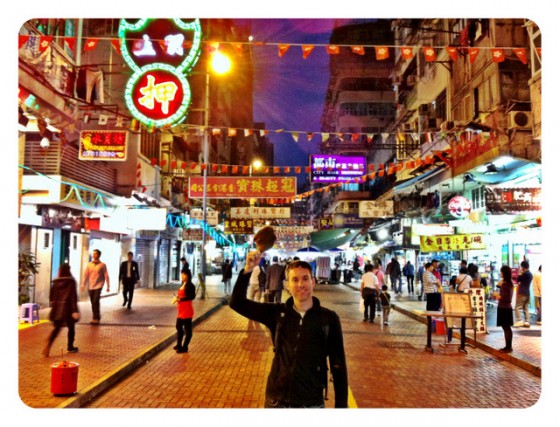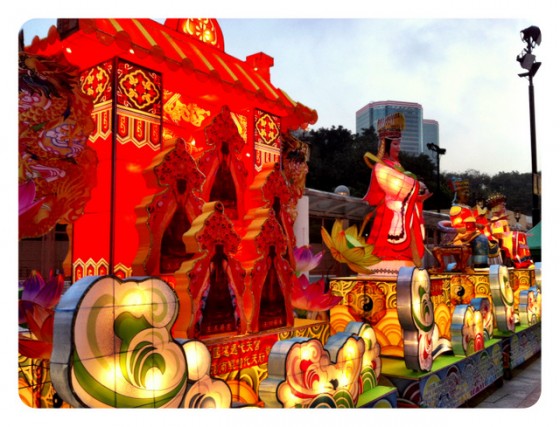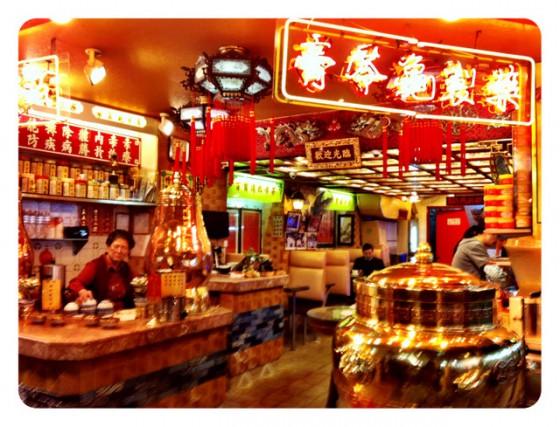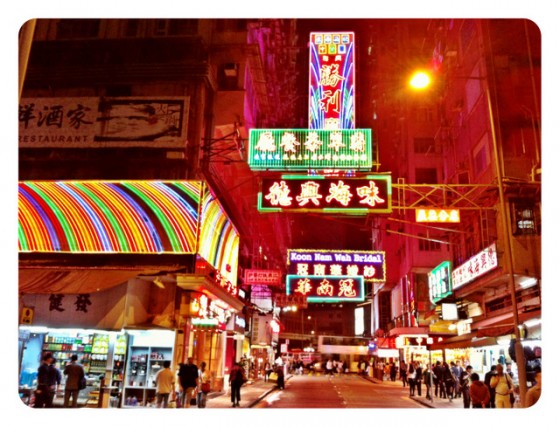Seventeen hours on an airplane. Ugh. Fortunately our non-stop trip from New York went very smoothly and it was easier logistically to reach Asia with no connections, but we were ever so glad to arrive in Hong Kong. Following the advice of Mark and Amy who greatly enjoyed their stopover in Hong Kong, we decided it would be an excellent opportunity to begin to recover from jet lag while exploring this city with such a fascinating past and future.
We stayed in Tsim Sha Tsui on the mainland, just at the tip of Kowloon peninsula. It is an interesting neighborhood, full of high-end fashion and jewelery shops, sparkling shopping malls and luxury hotels. Our accommodation was less luxurious but perfectly fine, we stayed in one of the many guest houses sprinkled throughout the highrise “mansions” along Nathan Road. Here the rooms are basic but comfortable and clean, with lightning-fast wi-fi and tiny “all-in-one” bathrooms that provide a sink, toilet and shower in a single square meter.
The guest houses have rooms spread over multiple floors and even buildings, but are efficiently run and with friendly, helpful service. We enjoyed staying in high-rise towers among the local people – we shared elevators with Hong Kongers (as well as immigrants largely from the Middle East), walked past drying laundry in the hallways, peeking in living rooms with sewing machines churning out tailored goods, and smelling the fragrant aromas of meals cooked in family kitchens. It was a treat to be immersed in the throes of Hong Kong domestic life.
The neighborhood is bustling with touts offering Rolex watches and custom-tailored suits who hounded Paul and me during our comings and goings. Tsim Sha Tsui is close to the famous Evening and Ladies’ markets selling all sorts of tourist trinkets, knock-off designer handbags, Mah Jong tiles, and fantastic street food featuring a bewildering array of fresh seafood. It is a busy area, as is most of Hong Kong, and we adapted quickly to the hustle and bustle in the streets.
We immediately noticed the British colonial influence on the society, which ended recently in 1997 when the United Kingdom returned sovereignty to China under the condition that the capitalist system and legal system remain largely intact for 50 years.
Asian through-and-through, we observed peculiar British traits everywhere, most prominently in the language: everything from street signs to menus to news media was in both Cantonese and English and most people speak English, at least a little bit. With a superb transportation system and helpful tourist information centers, navigating the city was easy.
Departing Kowloon peninsula, we caught the Star Ferry line to Hong Kong Island, a scenic introduction to the main island and commercial and financial center. We met an interesting father-son duo from Shanghai, also tourists. The son spoke English sufficiently well to have a conversation; they were exceedingly friendly and eager to meet Americans.
The son works for a large IT outsourcing company from the US, the father smiling and trying hard to express himself in English (with little successes, his foreign-language training consisted solely of Russian).
It was interesting to learn from the son that Mandarin is not widely spoken in Hong Kong, so they usually end up chatting with locals in English. Also, I had noticed lots of Hong Kongers texting each other on mobile phones with touch screens – I was not sure how they actually key in the Chinese characters into the touch screens, as well as on standard keyboards. He told me that the components of each character have a shorthand character that is used for input, a series of which is entered to compose a complete character.
On Hong Kong Island we visited the beautiful Botanical Gardens, marveling at the lush landscape and serene setting just a few hundred meters from the madness and noise of the metropolis. There were colorful birds, reptiles and even monkeys who entertained us for some time. The park was filled with the Hong Kong people who take full advantage of the many public parks that adorn the city.
Nearby Hong Kong Park was another green space delight. We climbed several stories to a lookout tower above the Tai Chi practice grounds (and SARS Memorial in tribute to the fast and effective response of the Hong Kong medical community) to appreciate the towering modern architecture soaring over the emerald hillside park. At the waterfalls and ponds, we found Hong Kong wedding couples posing for photographs on footbridges. We visited the Tea Museum in the former headquarters of the British military.
We continued our ramble through Hong Kong, stopping to see the sights highlighted in our guide, including the Man Mo Temple with dozens of locals offering up fruits, beverages, even fully cooked meals (in takeaway bags). In the older neighborhoods we spotted numerous family heritage temples tucked in the alleyways all smoky and fragrant with the burning incense joss sticks.
At night the streets are ablaze with neon signs. The markets also come alive, and Paul and I feasted on delicious vegetarian food: noodles, fried rice, buns, fruit, dim sum, and congee soup – every meal and snack was of excellent quality and delicious!
We also made the trek up to Victoria Peak, the famous funicular Peak Tram had been closed the day before for repairs so when we were ready to summit the lines were over 1.5 hours long. So we took the alternate route – local bus 15 from the Central Pier whisks passengers to the top every 10-15 minutes and the scenic ride up the winding mountain through up-scale neighborhoods was well worth it.
Up top we found ourselves amid hordes of tourists and of course a high-end shopping gallery, but the sweeping views of the setting sun to the west over the South China Sea and the scintillating lights from Hong Kong Island below was fantastic. A fine way to see our last sight of Hong Kong before our early wake up the next morning to continue our travels to Vietnam.
Hong Kong is especially fun to visit; it is friendly and orderly despite the massive crowds, the people pleasant and helpful, the public transport exceptional, and the sights accessible and worthwhile. It was the perfect stop to break up the long-haul journey from the Americas, and a model introduction to the New Asia that is on the rise.
Note: the photos above are from Paul’s Lightbox camera app on his iPhone. We especially like the tone and effects the application creates. I will be posting more “traditional” photos from my camera in the next post on Hong Kong.















Great post Peter! It makes me want to go back! Did you get to watch any Maj Jongg playing?
Thanks Amy, we are deeply indebted to you for your great insight into a “turbo tour” of Hong Kong. We were sure to visit your highlights and I can see how you and Mark came to love the city. It is a fascinating place, and wonderfully easy to enjoy!
As for Maj Jong, I did see several groups playing and it is fascinating how quickly they move the tiles. I was tempted to buy a set but quickly decided otherwise once I felt how they would weigh down my backpack for the next two months. If I stop in Hong Kong on the return journey, I very well may purchase set.
No crack!